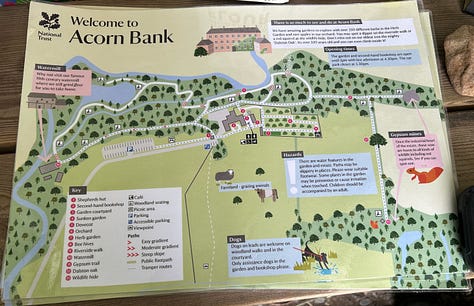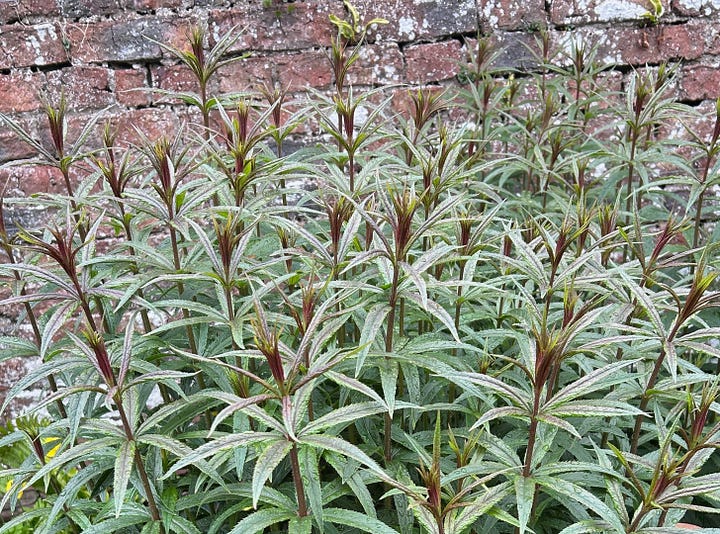Discovering Acorn Bank in Cumbria
Learn about an amazing range of herbs at this National Trust garden in the UK
Just off the M6 motorway in northern England, the garden at Acorn Bank offers a great example for anyone interested in herbs. Set nearby to the majestic green mountains of the Lake District, this is a small country house estate run by the National Trust and regularly open to the public. The notable herb garden is run by passionate gardeners and volunteers, and boasts a large collection of over 270 plant species.
A historical site



Although the Acorn Bank herb garden was not created until recent times, the whole estate has an interesting history dating back to the 13th century. The site was recorded as a religious house associated with the Knights Templar (who were Catholic crusaders), and it was subsequently owned by the Knights of the Hospital of St John. The buildings and land were seized by Henry VIII in the Reformation and sold off in 1543 to the Dalstons, a Westmorland family. Various extensions and improvements were made to the house in the 17th and 18th centuries by John and Lucy Dalston and their descendants, including walls and a sunken garden. Much of the woodland was felled in that time. Reports suggest that one of the garden walls was originally heated using internal horizontal flues and fireplaces so that apricots could be grown. There were some connections to Lady Anne Clifford (1590-1676) noted for her care of the poor and sick. Some of the apricots grown at Acorn Bank were given to her in the 1660s along with some damsons. Lady Anne Clifford had a longstanding connection with the Dalstons and she wrote decades later in her final years of visits by members of the Dalston family. For example, she wrote in March 1676 while at nearby Brougham Castle,
And today there dined with my folks in the Painted Room my cousin Mr John Dalston of Acorn Bank. So after dinner I had him into my chamber and took him by the hand and talked with him, and then he went away (p.259, Malay, 2018).
Changes in the 19th and 20th centuries
In 1810 the ownership of Acorn Bank passed to the Boazman family from County Durham. There were gypsum mine workings on the estate and these were extended so that some 4800 tons were being extracted yearly by the 1890s, and an associated tile and brick works was established to use the resulting clay by product. In 1934, the estate was bought by Dorothy Clough (1887-1967), better known as Dorothy Una Ratcliffe, a writer and poet who was part of the Arts and Crafts Movement. She closed the gypsum works and created a wilderness and wildlife garden in the surrounding woodland. Dorothy's great passion was collecting and writing about folklore, especially Romany life and customs. She introduced ornate railings and statues into the garden. Dorothy gifted the house with 180 acres of park and woodland to the National Trust in 1950. It was then used as a nursing home by the Sue Ryder Foundation until the 1990s.
Acorn bank today


Very little of the house remains to view today except a ground floor room and some stained glass windows relating to the owners over the centuries. Around the main house are various walled gardens, a considerable orchard and extensive vegetable plots. The herb garden is a modern introduction, established in an area previously cultivated for vegetables. Although it blends in beautifully with the nearby 17th century manor house, the herb garden design actually dates back to the 1960s, and was replanted in 2002-2003. I spoke with Bronwyn Thomas, Gardener and Volunteer Coordinator, who explained that the original designer was Graham Stuart Thomas (1909-2003). He was an English horticulturist active in restoring over 100 National Trust gardens, and widely known for his work on roses. Today we have the glorious yellow rose named after him 'Graham Thomas' and it is one I grow at home in the cottage garden for scent and repeat flowering! The Acorn Bank herb garden has an accessible layout with good-sized long level paths and side beds. The integrated mixture of layers of trees, shrubs and other plants is very much in keeping with the form of a medicinal forest garden based on woodland edges.


Elsewhere at Acorn Bank there are rose beds and other borders of flowers, such as paeonies. The orchard features select local varieties of apples as well as pears and medlars. The vegetable garden includes herbs for culinary use. Some glasshouses provide a sheltered spot for less hardy plants. There are a number of riverside and woodland walks, including a restored watermill where flour is still available ground in the traditional way. The gardens offer a seasonal approach so that there is always something new to see, some things are likely to be inspirational while others have just gone over.
The herb garden beds



I was really pleased to see so many trees and shrubs in addition to herbs in this garden. Every plant in this herb garden is regarded as a useful plant and has a recorded use. Many are medicinal or culinary but there are also strewing herbs, dye plants and herbs with a modern industrial use. There are around a dozen beds with groups of plants relevant to particular conditions or health matters. For example, there is a bed dedicated to 'breathing complaints' which includes historic lungwort in addition to ephedra, a modern practitioner-only use herb due to the constituent ephedrine, which is very useful in symptomatic support for asthma complaints. Everything is expertly labelled, and you can read more about the plant bed collections in a large poster size info sheet costing just £1.
⁃ Skin bed (includes marigold, comfrey, pokeroot for abscesses)
⁃ Digestion bed (includes astringent cranesbill, fennel and balmony)
⁃ Heart and love bed (includes rosemary, hawthorn and lily of the valley)
⁃ Head bed (includes ginkgo, betony, nasturtium to prevent balding!)
⁃ Womens' herbs bed (includes chaste tree, blessed thistle and beth root, a love potion)
⁃ Stress bed (includes borage, valerian, st john's wort)
⁃ Immunisation bed (includes garlic, boneset and echinacea)
⁃ Joints bed (includes bogbean and guelder rose)
⁃ Anticancer bed (includes globe artichoke, greater periwinkle and schisandra)
Of course, as always, information given here is general advice and it is vital to obtain qualified practitioner advice if you are seeking individual herb treatment.
Plant varieties and care


There is great variety in the herb garden with a mixture of native and introduced plants. As the herb garden area is divided into beds focusing on particular aspects of health treatment, bringing together examples of trees, bushes, perennials and annuals, it is actually a successful kind of forest gardening. The good soil and plentiful moisture offer an environment allowing many plants to grow lush and tumble over the bed edges. I admired one of the healthiest examples of roseroot (Rhodiola rosea) that I have seen. Some species need more tender care, chaste berry and myrtle, for example, are grown along with the grapevine in a glass conservatory. Visitors might imagine that a herb garden should be very restrained and tidy but this one defies expectations and billows healthily.


There are plants here that are poisonous too! My usual approach in the past has been to advise growers to avoid planting anything risky but the admirable approach at Acorn Bank is to show powerful plants and explain what dangers these plants present. And I found that there were some plants that I had not seen in person before including the North American culvers root (Veronicastrum virginicum) and baldmoney (Meum athamanticum). There is even a herb named after Acorn Bank, an aromatic yellow-leaved oregano variety.
People and volunteers


Every plant has the right conditions to grow at Acorn Bank, demonstrating the care and knowledge of the staff and volunteers. This herb garden may be small at around 15 m by 60 m but it is impressive. As I chatted with Bronwyn, she explained the work needed to keep this garden going. Since the garden is based on a clay soil and a wet climate much effort has been made to adapt the environment for plants that need drier conditions. This garden offers opportunities to learn about growing the plants and propagation too, and there are specimen plants for sale too. She told me that volunteers are always welcome. For visitors there are free herb garden tours, currently offered on some Sundays, check with the website. Previous events have included foraging walks and workshops on using medicinal herbs at home with an expert practitioner. If you are in the area then this is definitely a place to visit!


Getting there
Acorn Bank, Temple Sowerby, Penrith CA10 1SP
Visitor information website here… An entry fee is payable, car parking is available and is free for National Trust members. The site is signposted from the A66 Temple Sowerby bypass. There is a Penrith to Appleby bus service, number 563, which stops at Temple Sowerby, about 1 mile walk away by road. Much of the garden sited around the house is accessible but there are some steps. Access to the watermill is through the woodland. There is a cafe and an extensive second-hand bookshop. When we visited the cafe was not open so check online about opening times which can vary. Dogs on leads are allowed in the woodland, courtyard and bookshop but only assistance dogs in the garden.
My thanks to Heather Birkett, Garden and Outdoor Manager at Acorn Bank for additional detail for this post.
References
Clifford, Margaret. 1598. Physick & alchemye: Receipts of Lady Margaret, for elixirs, tinctures, electuaries, cordials, waters etc. WDHOTH/1/5. Cumbria Archive Service, Kendal.
Malay, Jessica L., ed. 2018. Anne Clifford’s autobiographical writing, 1590–1676. Manchester University Press.
Oxford Archaeology North. 2014. A historic landscape survey report, provides detailed archaeology at Acorn Bank, available online.
Shiner, Marion R. No date. Walled garden at Acorn Bank, Temple Sowerby, Cumbria, project report, University of Sheffield, available online.






